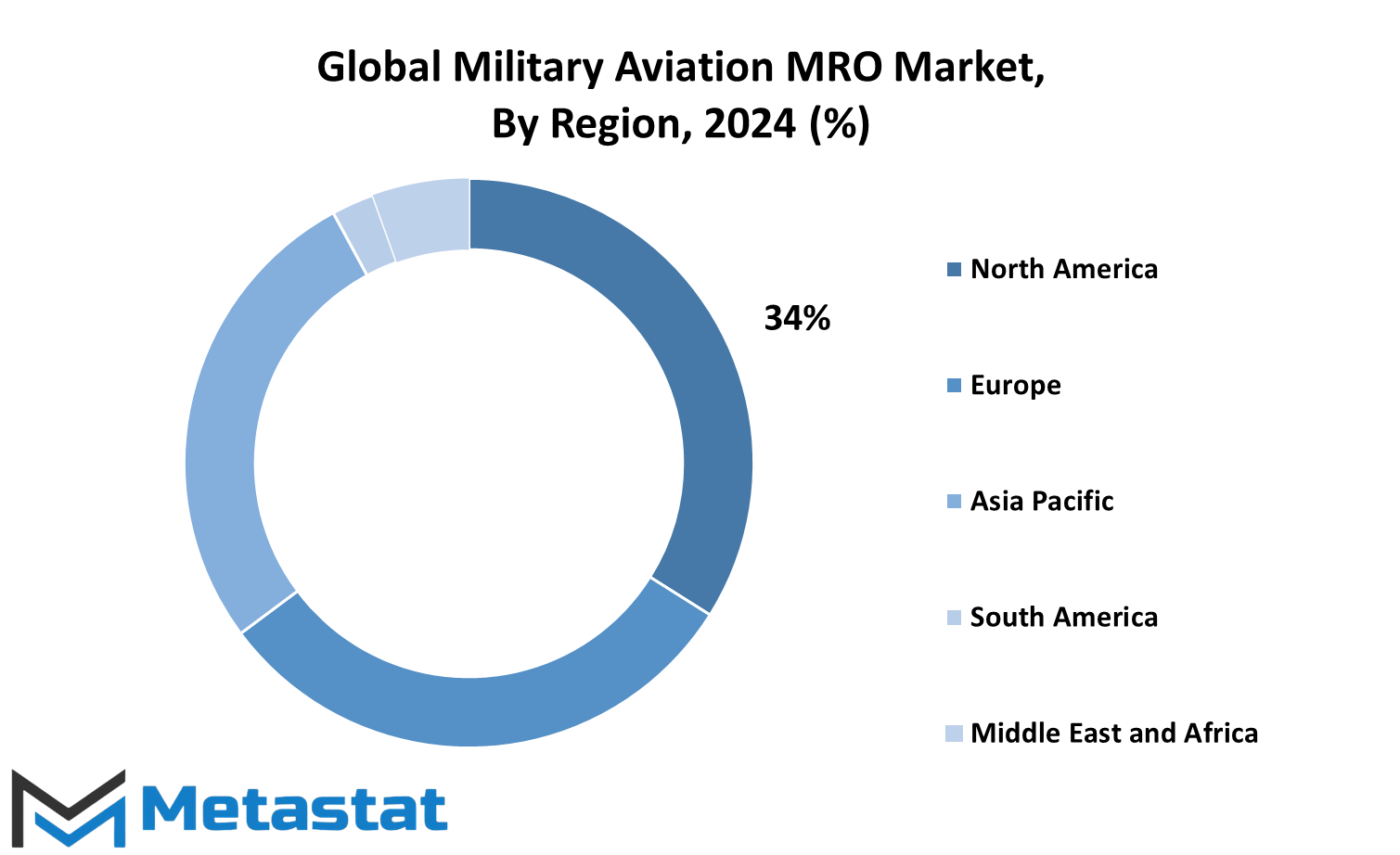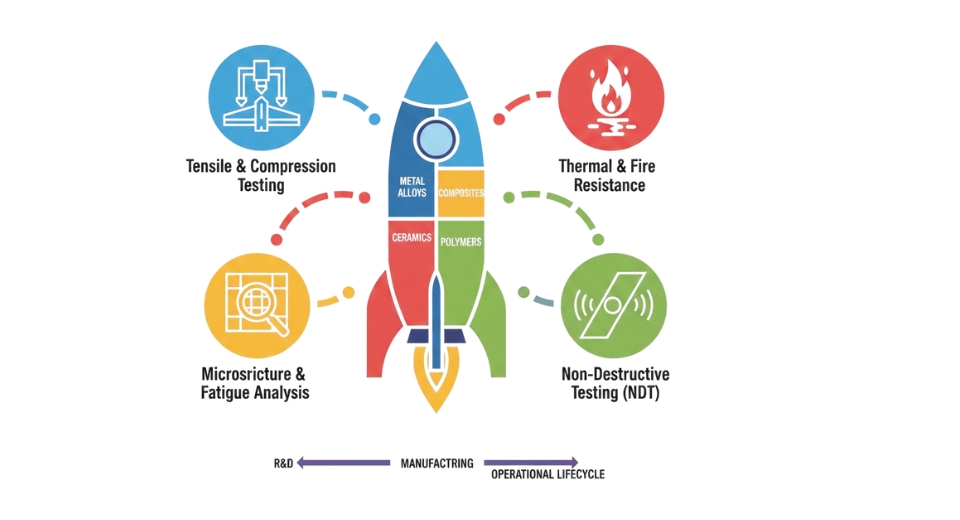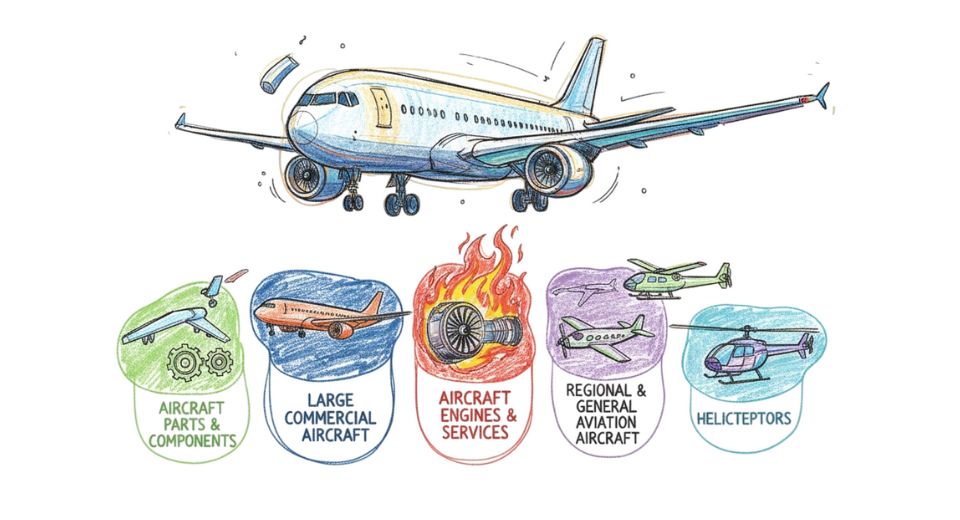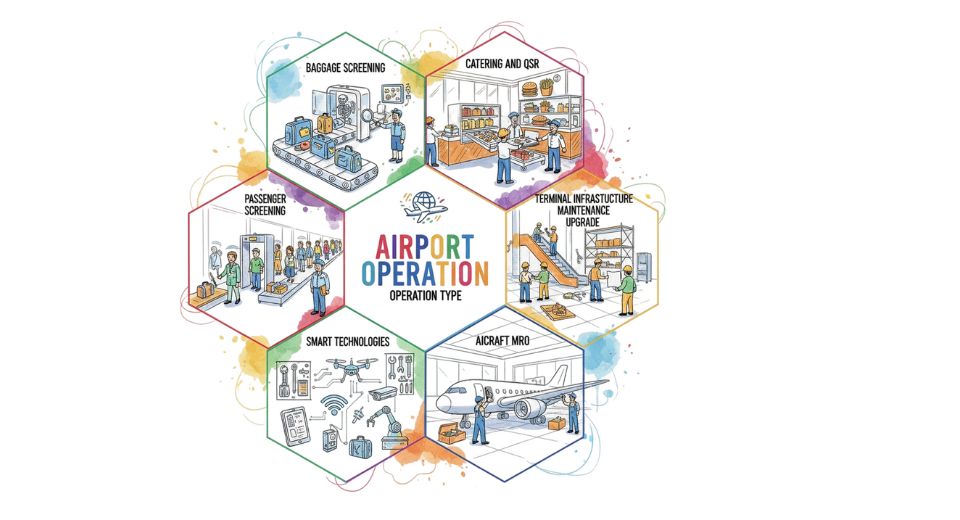MARKET OVERVIEW
Global Military Aviation MRO represents a niche sector- specializing in the maintenance, repair, and overhaul of military aircrafts. It is, therefore, an integral part of the defense industry, as it is the very backbone of the operational readiness of air forces and military aviation fleets worldwide. The MRO sector stands at a critical position where complexity and size have replaced modern military aircraft in fighter jets and bombers, transport aircraft, and reconnaissance drones. Military fleets stay mission-inoperable, technologically outdated, and unsafe for operation without proper MRO services. A market such as Global Military Aviation MRO provides the infrastructure and services needed to support the maintenance, repair, and upgrading of military fleets through intricate interplay of technology, logistics, and engineering expertise.
The international military aviation MRO includes a number of services, including scheduled maintenance, inspections, repairs, replacement of parts, and overhauls. There are also system updates, which can include avionics, communication equipment, radar systems, and weaponry. Not strictly mechanical servicing, international military aviation MRO also includes software and electronic system maintenance as well as structural integrity to maintain aircraft capability. Modern warfare relies more and more on precision, data-driven decisions, and technological supremacy; the MRO industry must therefore evolve and expand to add the latest in avionics, cybersecurity, and digital systems. Artificial intelligence and autonomous systems will be rife in military operations; there will be new demands on MRO providers who need to update software and maintain systems that integrate AI-based capabilities into aircraft.
Regional dynamics are another feature of the Global Military Aviation MRO market. Military superpowers like the US, China, and Russia are characterized by their very good established MRO networks supported by major infrastructural development, adequate funding, and indigenous technology. Smaller nations or countries with developing defense sectors normally depend on partnerships or third-party providers for fulfilling their MRO needs. Military aviation MRO services investments in regions likely exposed to geopolitical tensions or conflicts would be high as the nations would focus on turnaround times, resilience of the supply chain, and logistics logistics for optimal readiness levels. Therefore, the Global Military Aviation MRO market will have varied demand profiles, depending on the defense priorities, budgetary allocations, and strategic goals of each nation.
This market is likely to undergo rapid technological changes driven by the necessity of sustaining the next generation of aircraft and systems. Advanced avionics and stealth technologies in the fifth generation fighter jets require highly specialized MRO services, while older fleets continue to face increasingly high operational demands that are driving them for extended service lives. The market is also highly likely to be reshaped by digital innovations, such as predictive maintenance technology, where data analytics is used to prevent known or suspected problems ahead of time. The adoption of digital twin technology – which allows virtual replicas of physical assets that simulate and analyze their performance is also very likely to significantly reshape maintenance practices.
Further, defense budgets shall surge across the world, leading to more demand of MRO services. For the military aircraft fleet was never to falter by performing at its top order in terms of effectiveness of tasks assigned. Environmental regulation has further influenced the market as stringent nations’ pressure force manufacturers toward greener solution providers for the MRO processing procedure. The providers toward this will gradually shift their choice to more eco-friendly methods and more ecological materials, forcing them further to sustainable operations towards achieving zero environmental damages if it is possible.
Ever more critical to national security, this Global Military Aviation MRO market will be at the heart of defense system evolution and the development of advanced aircraft technology. As countries continue to modernize their fleets, the MRO industry will evolve to meet new technical requirements and logistical challenges. This market is set to grow in scope and sophistication, supporting military aviation worldwide as an essential component of national defence.
Global Military Aviation MRO market is estimated to reach $51.6 Billion by 2031; growing at a CAGR of 2.9% from 2024 to 2031.

GROWTH FACTORS
The Global Military Aviation MRO Market on its part will grow steadily driven by variety of factors that show up an increasing need of reliable and advanced military aviation support. Globally, all nations spend more on defense, with considerations for the maintenance and upgrade of military aircraft in a bid to ensure security and strategic defense capabilities. It is therefore one of the major growth factors in this market. Modern military aircraft are no doubt much more sophisticated and demanding of maintenance, requiring increasing expertise to serve their optimal performance and extend their lifespan. As a result, the growth in demand for expert MRO services rises with the global military aviation market.
The new requirements for safety and the environment play a second driver for the global military aviation MRO as aircraft maintenance is being advanced. These include growing regulations as part of environmental control measures and as safety technologies for aircraft, thus increasing the demand for upgraded parts, fuel-efficient systems, and high-end repair technologies. This trend supports continuous investments in MRO services that can address such evolving needs. In addition, military operations in challenging and remote locations are expanding with increased pressures on aircraft, thus placing greater demands on robust MRO capabilities. All these contribute to a strong foundation upon which the market can grow.
But there will be some restraints that may lead to negative growth in the global military aviation MRO market. Among those is the cost factor related to very expensive sophisticated MRO technology and service. For poor countries and small nations that do not have an efficient budget, it can be hard for them to rise with the increments of the costs and might, therefore, lower the growth level in some regions. Another possible growth constraint is that of scarcity of qualified technicians to handle the maintenance of modern military aircraft. As military aircraft become more and more technologically sophisticated, MRO service providers must recruit and train skilled personnel to meet the ever-higher technical demands presented by them which often involves hefty and laborious investment.
Despite this, yet significant opportunities abound in this global military aviation MRO market. Use of digital solutions, including artificial intelligence-based predictive maintenance, may revolutionize the sector. Predictive maintenance, particularly artificial intelligence-based predictive maintenance, leads to early detection of potential issues, reduces unwanted breakdowns, and cuts an aircraft's life cycle. The technologies therefore seem promising enough to bring down costs over time and improve efficiency. Besides, to curb foreign dependency in defense systems, investments in indigenous MRO facilities are estimated to increase further in the forthcoming years and thereby boost market growth.
To sum it up, despite the hurdles identified, military aviation MRO global market is going to witness growth as countries invest in high-end maintenance services and sophisticated high-tech devices as part of a future firmly in development and innovation.
MARKET SEGMENTATION
By Service Type
The Global Military Aviation MRO market has a lot of growth potential in the years ahead, fuelled by the continued demand from military aircraft to be operationally ready and technologically updated. Military aviation needs continuous maintenance to guarantee that airframes are safe, reliable, and technologically up-to-date. MRO services are, therefore crucial in satisfying all these requirements, given that they help extend the life span, and keep current and fit for complicated missions. With the progression of technology at such a rapid pace, high-tech MRO services in military aviation are a must. The Global Military Aviation MRO market is thus expected to witness significant growth due to the incorporation of more streamlined processes and cutting-edge systems by defense agencies into their fleet. This may include a myriad of specialized services unique to each component and function of military aircraft.
The market can also be segmented into main service categories: Engine Maintenance, Airframe Maintenance, Component Maintenance, and Line Maintenance. Each of the types of services performs a particular function affecting overall readiness and capability of military aircraft to perform. For instance, Engine Maintenance ensures propulsion readiness because the engines are thoroughly inspected and replaced for high standards to survive intensity in mission performance. The airframe maintenance is also considered similarly important, wherein the structural assembly integrity of the aircraft is emphasized. By inspecting and managing the problems in the airframe, MRO service providers help avert failures due to structural integrity and ensure that the aircraft can remain longer. Component Maintenance includes all other smaller parts necessary to ensure that an aircraft flies high and not otherwise: avionics, landing gear, and so on.
With growing advancements in military technology, this MRO area keeps getting complicated as more advanced components are being installed in aircraft systems. Line Maintenance is the other category that encompasses day-to-day checks and fixes between flights for quick identification of issues that may affect direct missions. It is very important in active zones to ensure quick turnaround times. Trends Looking ahead, the Global Military Aviation MRO market is likely to grow in parallel with surging global defense budgets and increased attention towards modernization.
The next generation of aircraft for many nations is driving MRO requirements towards the management of advanced technology and complex systems. Predictive maintenance methods utilizing data analytics, such that problems may be foreseen even before they occur, will become more prevalent within this market. This may make military aviation even more efficient and responsive: the aircraft will stay mission-ready, while at the same time the situation of the downtime is drastically reduced. Sustainable and cost-effective solutions may further define the future of MRO services with respect to both performance and value over time.
By Platform
The Global Military Aviation MRO market is well-situated to take off on high growth prospects, driven by both technological advancements and rising initiatives for military fleet modernization. This market-focus maintenance and readiness improvement of operational militarily aircraft-draws coverage in fixed-wing, rotary-wing aircraft, unmanned aerial vehicles, and other specialized platforms. All these components have individual service life and maintenance needs, which are dictating the manner in which MRO suppliers are structuring their offerings, and as defence budgets expand worldwide, the contribution of this market to military airpower will only continue to expand.
For fixed-wing aircraft, the bedrock of all air forces, the main focus of MRO efforts tends to be directed at increasing performance and extending the lifespan of aircraft. This category consists of fighter jets, bombers, and transport aircraft, all of which have extremely demanding requirements. Future trends are likely to emphasize predictive maintenance technologies where data analysis will be used proactively to identify parts and systems that require attention. This besides reducing time spent at the hangar also improves operational readiness, a critical component for quick-strike capabilities.
Rotary-wing aircraft, in the form mostly of helicopters, are to serve critical missions in a host of rescue, transport, and direct battle operations. Such unique flight dynamics often mandate unique maintenance processes that allow them to operate safely. MRO services will, most probably add more sophisticated monitoring systems aimed at fighting the different types of wear and tear exhibited by helicopters in the coming years. Advances in rotor blade materials and technologies will also be of great interest in making it possible to create more resilient and able-to-endure environments rotary-wing aircraft.
Unmanned Aerial Vehicles will also be a major aspect in the military aviation MRO market, which will see specific maintenance demand for those platforms that increasingly are being used in military missions, for surveillance, reconnaissance, and even for offensive missions. Thus, MRO providers might still invest in technologies to improve UAV reliability and mission duration of UAVs, along with solutions for changing components at a adequate speed to maintain long missions. All these play a very crucial role for assured UAV readiness for quick deployment.
The Global Military Aviation MRO market would develop in ways to adapt the new defense needs and technological trends such as automation and AI process in maintenance areas. These areas will look toward better mission readiness, faster turnaround, and reduced costs. In short, growth will be motivated by the worldwide need for strong, deployable air capabilities, which will get the military forces ready for any situation that may arise in the years ahead.
By End-User
The Global Military Aviation MRO market will continue to experience high growth since a number of countries around the globe are now improving their military capability. Military aviation maintenance, repair and overhaul (MRO) is a critical requirement towards ensuring the preparedness, dependability, and efficiency of defense aircraft, considering the prodigious advancements of technology with regard to aviation. As defense forces, government agencies, and private contractors look for solutions to maintain and modernize their fleets, demand for MRO services underpins tremendous growth. Scheduled and unscheduled repairs, component overhauls, and performance upgrades to extend the lifespan of military aircraft for safety and performance standards that continue to tighten.
Advanced and reliable aircraft are needed for military forces across the globe to achieve strategic edges. This remains a critical requirement in the MRO market, considering recent development in military fleets such as drones, advanced radar capabilities, and navigation. The next generation of the Global Military Aviation MRO market will use these technologies to strive for more autonomous and AI-aided maintenance processes, as these reduce the scope for human error and bring about greater efficiency. For instance, predictive maintenance, powered by AI, identifies mechanical or electrical faults well before they turn into full-blown issues, hence reducing downtime and cutting military forces’ costs. The future of military aviation MRO is mostly going to be dictated by the level of emphasis on technology-driven solutions.
Government bodies are also quite significant contributors to the market, inasmuch as they seek to maintain national fleets in an optimal condition. Expectedly, due to rising geopolitical tensions and the modernization of defense strategies, investment in MRO services should increase for government agencies. This increased focus on MRO will be accompanied by more stringent safety procedures and green-friendly processes, indicative of intensifying environmental concerns. Green technologies, such as fuel-efficient engines and readily available sustainable materials for aircraft, will increasingly be part of the market and will move in unison with the government’s efforts toward achieving environmental sustainability.
Privatized companies will be a key driver of the Global Military Aviation MRO market in terms of support. They bring specialized skills, resources, and innovation into military aviation maintenance. Their skills can be beneficial for complex repairs and modifications, while their innovative solutions are likely the areas in which traditional military forces and government agencies do not have the resources or time to develop. Private contractors probably become more integral as outsourcing increasingly becomes a mainstream strategy for meeting the complex demands of the modern military.
With emergent modernization needs and trends in military technology, this market, in different fields of complexity and scope, will continue to advance around the globe. Increased cooperation between the military forces, government agencies, and private contractors will ensure that the sector remains at the forefront of innovations toward greater military aviation efficiency, safety, and sustainability.
|
Report Coverage |
Details |
|
Forecast Period |
2024-2031 |
|
Market Size in 2024 |
$42.1 billion |
|
Market Size by 2031 |
$51.6 Billion |
|
Growth Rate from 2024 to 2031 |
2.9% |
|
Base Year |
2022 |
|
Regions Covered |
North America, Europe, Asia-Pacific Green, South America, Middle East & Africa |
REGIONAL ANALYSIS
Military Aviation MRO market to see huge growth. With new technologies, increasing demand for the advanced capabilities in military will give it an absolute boost. The global market of MRO of Military Aviation will comprise all the aspects that ensure military aircraft readiness. Presently, most countries are focusing on sound strategies of MRO for aircraft. The advancement in aircraft technology and the complexity of military missions have made the MRO services far more sophisticated and critical ever.
The global Military Aviation MRO market, geographically, is spread across various key regions - North America, Europe, Asia-Pacific, South America, and Middle East & Africa. North America, which comprises the U.S., Canada, and Mexico, is one of the key players in this market because of its high defense budgets and constant emphasis on maintaining air superiority. For example, the United States spends a lot on MRO services to ensure that its fleet is always in the best condition, and other countries take cue from it.
In Europe, the UK, Germany, France, and Italy are enhancing their military aviation. The modernization of fleets and the increase in joint defense agreements across Europe have forced high demand for quality MRO services. When these countries are building up to the strength of their defense capabilities, MRO services will be highly necessary to complement the readiness of military aircraft to new and emerging tasks.
The Military Aviation MRO market is expanding rapidly in the Asia-Pacific region as well. Countries in the region like India, China, Japan, and South Korea are making high investments in their military aviation sectors. These countries have been spurred by growing tensions in many Asian regions and the need to have an independent defense apparatus. The market in this region is expected to continue growing as countries look to upgrade fleets and move towards less reliance on foreign MRO services.
South America, including Brazil and Argentina, is also in motion in the Military Aviation MRO sector. While budgets tend to be lower across this region, there is still a drive to maintain operational readiness within constraints. Similarly, the Middle East & Africa, with large contributions from GCC countries, Egypt, and South Africa, is witnessing an increase in MRO activities. Regional tensions and strategic focus on defense preparedness are driving investments in MRO services to support military aviation fleets.
Looking ahead, the Military Aviation MRO market will probably continue its growth trend as countries increasingly focus on preserving strong, responsive air capabilities. Emerging technologies in predictive maintenance, advanced diagnostics, and automation will work towards making operations in MRO even more efficient. With increased regional focus on defence, it will ensure that MRO for Military Aviation is integral to supporting global military readiness in the years to come.

COMPETITIVE PLAYERS
The Global Military Aviation MRO market is expected to grow considerably in the next years, mainly because of technological advancements and higher defense spending, which will require maintenance, repair, and overhaul. This is a vital market that enables military aviation fleets to stay in continuous operation. Military Aviation fleets include various diversified aircraft used in defense, surveillance, and combating. The role of MRO in this area goes beyond the traditional maintenance work and encompasses some vigorous checks, repair, and upgrading of various systems associated with aviation, with military asset capability remaining at an all-time high to provide effective capability in today's modern combat and support roles.
The Global Military Aviation MRO Market is poised to see greater competition from the large entities as the market matures further. Other firms offering MRO services are Lockheed Martin, Northrop Grumman, Raytheon Technologies (Collins Aerospace), Boeing Defense, and General Dynamics. Each company crafts its solutions to meet the needs of the military aircraft - by incorporating the latest technology, ensuring improved safety, or eventually reducing costs over the long term. Their R&D investments must be sustained to maintain the military fleets operationally effective, handling intricate complexities in scenario-based operations.
Companies BAE Systems, Airbus U.S. Space & Defense, Leonardo S.p.A, and Rolls-Royce Holdings should spearhead MRO innovations by starting the use of AI, data analytics, and predictive maintenance in their services. These technologies can identify anomalies earlier in the situation when things are not yet disastrous and thus minimize the time spent on repair and avail the fleets. As environmental issues also rise to the concerns, MRO providers like MTU Aero Engines AG, L3Harris Technologies, and SAFRAN Group work toward greener practices and materials which may reduce the environmental footprint of military aviation activities. Probably, transitioning into more sustainable MRO methods will become an added competitive advantage for those companies striving to meet both defense needs and sustainability targets.
The Thales Group and Textron Aviation, with the heritage of long experience in aviation technology, will also play a shaping role in the Global Military Aviation MRO market. At the same time, as the industry continues to advance, companies are likely to offer more complex upgrades and retrofits to older aircraft, which will contribute to sustaining advanced capabilities in military operators without new fleets. The expansion of the MRO market should follow through with the improvement of military budgets in key regions.
In short, competitive dynamics will need to be balanced and set forth by hegemonic defense contractors and newer generation companies that are driven by technology. Their joint reliance on reliability, innovation, and sustainability will then determine the future course military aviation MRO services take-sure that military aircraft around the globe are in position for mission deployment in the increasingly changing defence landscape.
Military Aviation MRO Market Key Segments:
By Service Type
- Engine Maintenance
- Airframe Maintenance
- Component Maintenance
- Line Maintenance
By Platform
- Fixed-Wing Aircraft
- Rotary-Wing Aircraft
- Unmanned Aerial Vehicles (UAVs)
- Others
By End-User
- Military Forces
- Government Agencies
- Private Contractors
Key Global Military Aviation MRO Industry Players
- Lockheed Martin Corporation
- Northrop Grumman Corporation
- Raytheon Technologies Corporation (Collins Aerospace)
- Boeing Defense, Space & Security
- General Dynamics Corporation (Jet Aviation Inc.)
- BAE Systems
- Airbus U.S. Space & Defense, Inc.
- Leonardo S.p.A.
- Rolls-Royce Holdings plc
- MTU Aero Engines AG
- L3Harris Technologies, Inc.
- SAFRAN Group
- Thales Group
- Textron Aviation
WHAT REPORT PROVIDES
- Full in-depth analysis of the parent Industry
- Important changes in market and its dynamics
- Segmentation details of the market
- Former, on-going, and projected market analysis in terms of volume and value
- Assessment of niche industry developments
- Market share analysis
- Key strategies of major players
- Emerging segments and regional growth potential








 US: +1 3023308252
US: +1 3023308252






